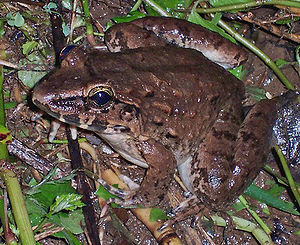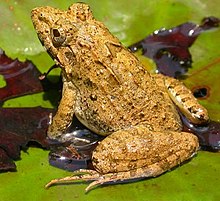Dicroglossidae
| Dicroglossidae | ||||||||||||
|---|---|---|---|---|---|---|---|---|---|---|---|---|

Tooth frog ( Limnonectes macrodon ) |
||||||||||||
| Systematics | ||||||||||||
|
||||||||||||
| Scientific name | ||||||||||||
| Dicroglossidae | ||||||||||||
| Anderson , 1871 |
The Dicroglossidae are a family of frogs found in tropical and subtropical Africa and Asia .
distribution
Most species of the Dicroglossidae occur in the subtropical and tropical regions of Asia, from Afghanistan via Pakistan and India as well as Sri Lanka to the east through Nepal and Myanmar to the western and southern People's Republic of China and to Southeast Asia and on some of the Sunda Islands to the Philippines and to Japan . In Africa, representatives of the Dicroglossidae are widespread in the northwest and south of the Sahara to the Arabian Peninsula .
Systematics and taxonomy
The Dicroglossidae were separated from the family of the real frogs (Ranidae). Their phylogenetically independent position is now regarded as secure. The name Dicroglossidae is based on a misspelling of the name derived from the genus Discoglossus ("disc tongue"), but the ICZN commission decided to keep this spelling.
Subfamilies and genera
The phylogenetic extent of the family and thus the number of genera are subject to fluctuations. There are few morphological features that distinguish the genera, and so only molecular biological studies can provide information on how the individual genera and species are to be divided.
It becomes the two subfamilies
- Dicroglossinae and
- Occidozyginae differentiated.
Dicroglossinae
The subfamily Dicroglossinae currently comprises twelve genera with a total of 193 species. The genus Zakerana was synonymous with the genus Fejervarya in 2015 , as was the genus Minervarya . The former genera Minervarya and Zakerana , however, form a clade in South Asia , which can be distinguished from the rest of the Fejervarya species from Southeast Asia by their geographical distribution . Therefore, the two synonymized groups were recognized again as a separate genus in 2018 under the name Minervarya .
As of February 1, 2019
- Allopaa Ohler & Dubois, 2006 (2 species)
- Chrysopaa Ohler & Dubois, 2006 (1 species)
- Euphlyctis Fitzinger, 1843 (8 species)
- Fejervarya Bolkay, 1915 (12 species)
- Hoplobatrachus Peters, 1863 (5 species)
- Limnonectes Fitzinger, 1843 (73 species)
-
Minervarya Dubois, Ohler & Biju, 2001 (39 species)
- Minervarya asmati (Howlader, 2011)
- Nannophrys Günther, 1869 (4 species)
- Nanorana Günther, 1896 (28 species)
-
Ombrana Dubois, 1992 (1 kind)
- Ombrana sikimensis (Jerdon, 1870) = Chaparana (Paa) sikimensis
- Quasipaa Dubois, 1992 (11 species)
- Sphaerotheca Günther, 1859 (9 species)
Occydozyginae
The subfamily Occidozyginae comprises two genera with a total of 16 species:
- Ingerana Dubois, 1987 (4 species)
- Occidozyga Kuhl & Van Hasselt, 1822 (12 species)
Individual evidence
- ↑ a b c d Darrel R. Frost: Dicroglossidae Anderson, 1871 Amphibian Species of the World: an Online Reference. Version 6.0. American Museum of Natural History, 1999-2018, accessed February 1, 2019
- ↑ a b K. P. Dinesh, SP Vijayakumar, BH Channakeshavamurthy, Varun R. Torsekar, Nirmal U. Kilkarni & Kartik Shanker: Systematic status of Fejervarya (Amphibia, Anura, Dicroglossidae) from South and SE Asia with the description of a new species from the Western Ghats of Peninsular India. Zootaxa, 3999, 1, pp. 79-94, 2015 doi : 10.11646 / zootaxa.3999.1.5
- ^ E. Sanchez, SD Biju, MM Islam, MK Hasan, A. Ohler, Miguel Vences & A. Kurabayashi: Phylogeny and classification of fejervaryan frogs (Anura: Dicroglossidae). Salamandra, 54, pp. 109-116, 2018
literature
- MSA Howlader: Cricket frog (Amphibia: Anura: Dicroglossidae): two regions of Asia are corresponding two groups . Bangladesh Wildlife Bulletin, 2011, 5, pp. 1-7. on-line
Web links
- Darrel R. Frost: Dicroglossidae Anderson, 1871 Amphibian Species of the World: an Online Reference. Version 6.0. American Museum of Natural History, 1999-2018, accessed February 1, 2019

